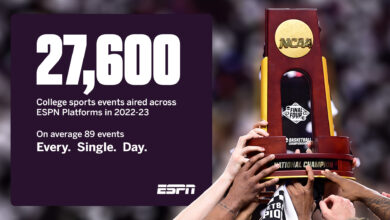Dispelling ratings myths with Artie Bulgrin

(Rich Arden/ESPN Images)
There seems to be an article in the media every day about the presumably perilous state of television’s popularity. As ESPN enters its strongest part of the year – college football and the NFL are heating up while the NBA and college basketball are about to tip off – here to cut through the clutter, assumptions and myths is ESPN Senior Vice President, Global Research & Analytics Artie Bulgrin. Bulgrin is one of the industry’s most-respected voices, having worked on both sides of the aisle. He started his career at Nielsen before joining ABC Television in 1989. Next year, he’ll celebrate 20 years with ESPN.
Artie, looking at the last 12 months, two years ago ESPN was No. 3 among cable networks in total day in our key sales demo (P25-54), and now we’re No. 1. Similarly, three years ago in prime time, ESPN was No. 3 in overall viewers (P2+) and P18-34, P18-49 and P25-54… now we’re No. 1 in all four. What’s been happening?
This is about the unique appeal of live sports content in the increasingly on-demand world of TV. Our news and info and studio programming continues to drive daily tune-in levels that lead the competition. And in prime time, our audience levels remain strong due to the strength of our live events while competing entertainment networks are losing audience. We used to rank behind networks like USA and TBS, but in the last two years their ratings have declined. Our ratings have held up. In fact our prime-time audience share has grown five percent among persons 18-49 and three percent among P25-54. So in a world where virtually all entertainment TV content can be time-shifted, live sports has become a priority in the hierarchy of viewing during prime time. Case in point: in the past 12 months, ESPN “won the night” across all broadcast and cable networks in prime time 47 times among M18-49 – the most wins for any network.
You have worked in TV research your entire career. In that time, how has the perception of sports changed among advertisers?
When we talk about the highest level of premium TV content where advertisers can be confident that their ads will have impact in real time and with scale, sports now stands alone. It is the only genre setting new records for audience levels, as we did this year for the College Football Playoff Championship game and the two semifinals.
In this day of much “doom and gloom” in the media about TV’s place in people’s lives, what’s the one thing you would like people to know?
To paraphrase Mark Twain, the reports of TV’s death have been greatly exaggerated. The average adult spends most of his/her media time with TV – 4 hours and 40 minutes a day. More than all other sources combined.







